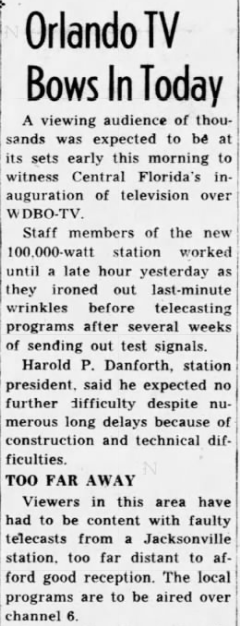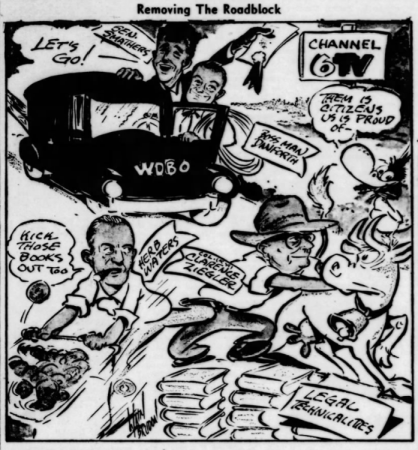Channel 6 signed on the air and local television arrived in Orlando on July 1, 1954. The first regular broadcast by WDBO-TV at 7:55 a.m. on that Thursday was the culmination of a more than four-year effort to bring local TV to Central Florida.

Orlandoans had been able to watch television for years — but they were snowy, blurry broadcasts coming mostly from WMBR-Channel 4 in Jacksonville and from stations as far away as Baltimore, Cleveland, Kansas City and Kalamazoo, Mich., when atmospheric conditions were just right. But viewing distant signals only whetted the appetite of those wanting a local television station.
And while Orlando was ready for TV in the early 1950s, the Federal Communications Commission wasn’t.
In September 1948, after some early stations were approved or launched in 70 cities across the nation including Miami and Jacksonville, the FCC froze approval of all television station applications for nearly four years. It needed the time to address issues including a national channel allocation map, designations for educational and non-commercial stations and a standard for color broadcasting. It took until April 1952 for the FCC to finally lift its freeze and start sorting through the hundreds of applications for TV stations across the nation.
Included in that pile were submissions from Orlando radio stations WDBO, WHOO, WORZ and WLOF, as well as from some local individuals.
In its freeze-lifting ruling, the FCC had allocated four channels for Orlando — VHF channels 6 and 9, plus UHF channels 18 and 24 (the latter was designated for a non-commercial station). But there was really only interest in the two VHF channels since most TV sets at the time didn’t even have tuners for UHF stations.
Toward the end of 1952, the TV competition sorted out this way: Channel 6 was being sought by WDBO and Central Florida Enterprises, a local business group led by Herb Waters, who owned an Orlando restaurant called Do-Nut Dinette; Channel 9 was the focus of a three-way battle among radio stations WHOO, WLOF and WORZ.
It was going to take years for the FCC to hold hearing and vet all the different candidates before it could award an Orlando station to any one of the competing groups.
“How We Can Get TV in 10 Days”
By mid 1953, after seeing Fort Lauderdale, St. Petersburg, West Palm Beach and Pensacola join Miami and Jacksonville as Florida cities with TV stations, Orlandoans had enough of the fighting over local TV frequencies. The Orlando Sentinel began crusading to get television here, and on the morning of June 19, 1953, the top of its front page carried this shocking statement: “How We Can Get TV in 10 days.”
It promoted an editorial inside the newspaper that started in an equally shocking manner, casually using a disgusting racial epithet — a sad reminder of what life was like in the South and in Central Florida at time:
“The Sentinel has been writing editorials for seven or eight weeks now, trying to smoke ‘the [n-word] out of the woodpile,’ as the saying goes. This means this this newspaper, fighting almost a lonely battle, has been attempting with editorials, letters, phone calls, logic and reason to unfreeze the frozen area of Orlando and Central Florida; fighting to remove the road-blocks and rewrite and revise the regulations which have prevented Orlando from enjoying TV service.”
It continued, “Meanwhile, we learn the startling news that Orlando can get a TV station grant in about 10 days if one of the two applicants for Channel 6 would withdraw, drop the fight.” The newspaper went on to endorse WDBO’s effort to win Channel 6.
“On the surface, in a contest, it would appear that WDBO would win the TV grant hands-down against Central Florida Enterprises, Inc. or almost any other corporation getting its feet wet in the TV or radio business. This does not mean that the officers of the new company are not good business men … it does mean, however, that WDBO and it officers and employees have been in radio in Orlando ever since there was a station; it means that WDBO and its personnel have kept up with the science and industry and perhaps have forgotten more about the business than a newcomer corporation would learn in five our six years.”
Do-Nut man delivers TV to Orlando

It took a nearly four months for the newspaper’s call to be heeded. On Oct. 13, 1953, Herb Waters walked into the Orlando Sentinel newsroom and informed the staff that Central Florida Enterprises was withdrawing its application for Channel 6.
With the front-page lead headline “Withdrawal Clears Way for TV in City,” the Sentinel reported: “Mr. Waters, who operates the Do-Nut Dinette on Mills St. in Colonialtown, said the withdrawal was made purely and simply because ‘my associates and I feel that Orlando ought to have television as soon as possible.'”
The Sentinel immediately informed Florida Sen. George Smathers in Washington about the news. The paper said an aide to Smathers then alerted FCC Chairman Rosel Hyde, who “rushed his staff to clearing WDBO’s application.”
The next day, on Oct. 14 at 3:48 p.m., the FCC announced WDBO’s application for Orlando’s Channel 6 had been granted.
James Yarborough, who was WDBO’s vice president and chief engineer, estimated at the time it would take six months to get the station on the air but said, “we’ll try to beat that time.”
Technical issues, including too much Central Florida lightning while Channel 6’s tower and transmitter were being constructed and installed, pushed the sign-on date to nearly nine months after the time of the FCC’s approval.
In between, the station built its new broadcast facility on Texas Avenue off Colonial Drive in West Orlando, and it signed with CBS to become the network’s Orlando affiliate — though it was also given permission to air shows from NBC, ABC and the DuMont network, too.
But, finally, on the morning of July 1, 1954, WDBO-TV signed on as Orlando’s first television station and the 12th in the Florida.
First day on the air
Channel 6 switched on its transmitter at 7:55 a.m. And the first network program broadcast on the nation’s newest CBS TV affiliate was … ABC’s “Don McNeill’s Breakfast Club.” In fact, on its first day, the CBS station carried few if any CBS shows, opting instead for ABC’s “News with John Daly” and “The Lone Ranger,” and NBC’s “Ford Theatre” show.
This may have been in part to give Orlando viewers more TV options, since they could still receive CBS shows via the fuzzy signal from Jacksonville’s WMBR-TV.
Orlando was also one of the Florida towns through which the TV networks’ telephone coaxial cable ran, meaning that a variety of network programs could be picked up and aired live here.
Still, Channel 6’s first day included several local shows too, like “Homemaking is Fun with Betty Arwood,” “Charm Chat with Philena Barden” and the first TV episode of the long-running kids show, “Adventures with Uncle Walt.” There was also a 15-minute “Weather-News-Sports” show at 6 p.m.
The early schedule called for Channel 6 to broadcast Monday-Friday from 7:55 a.m. to 11:30 p.m., Saturdays from 10:25 to 11:30 p.m. and Sundays from 2:55 p.m. to 11 p.m.
WDBO-TV would have the local airwaves to itself for nearly two years until Daytona Beach’s WESH-Channel 2 started on June 11, 1956, and Orlando’s WLOF-Channel 9 started on Feb. 1, 1958.

